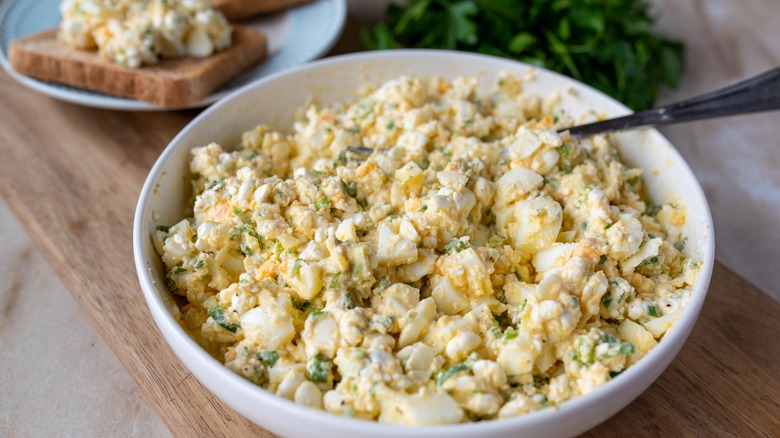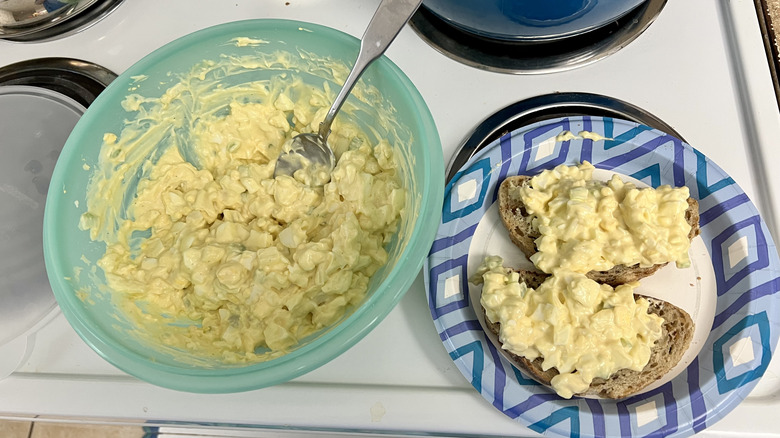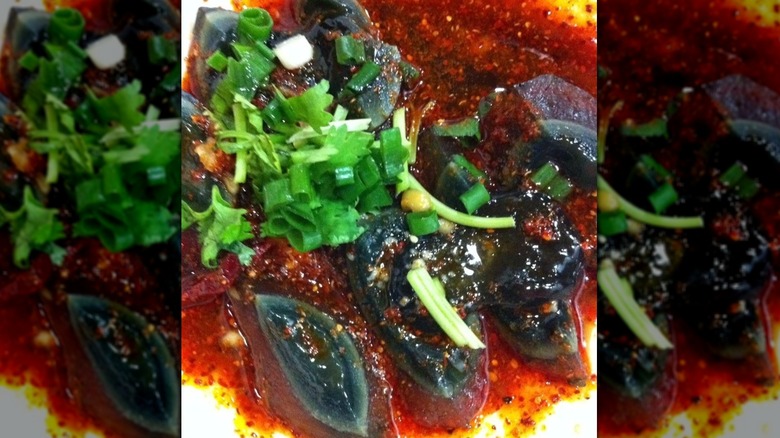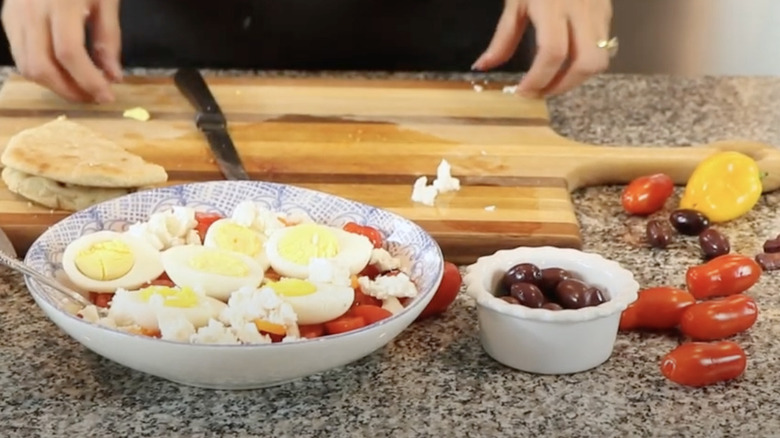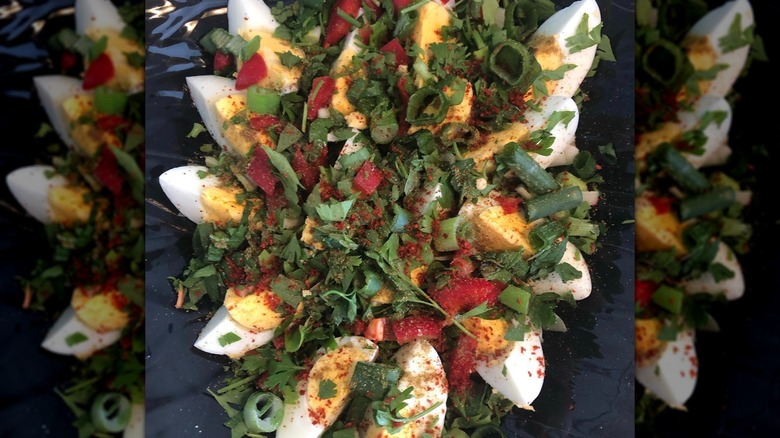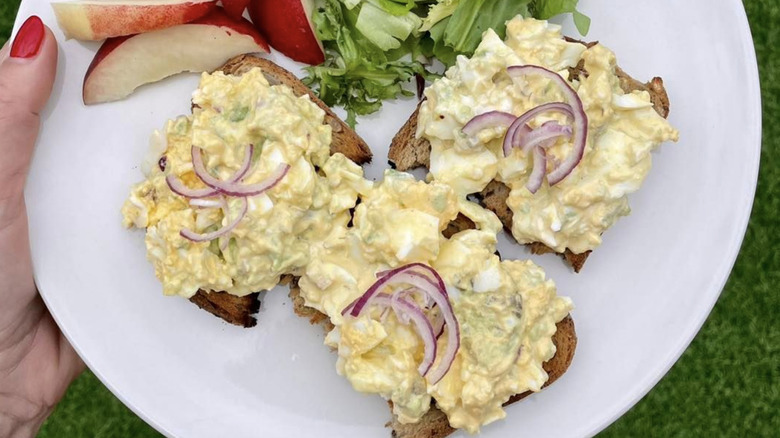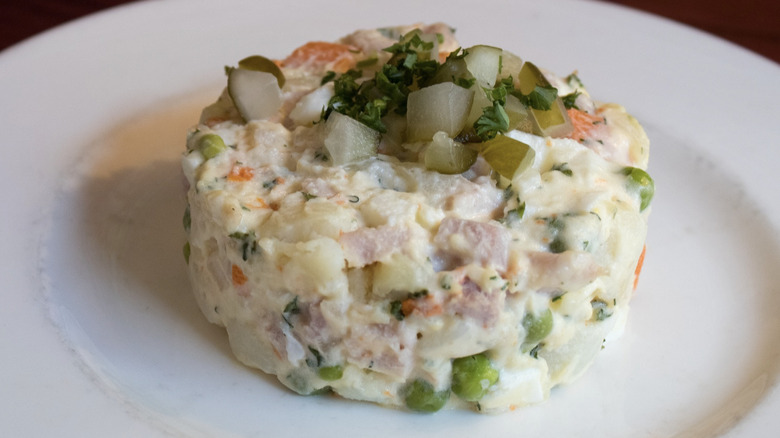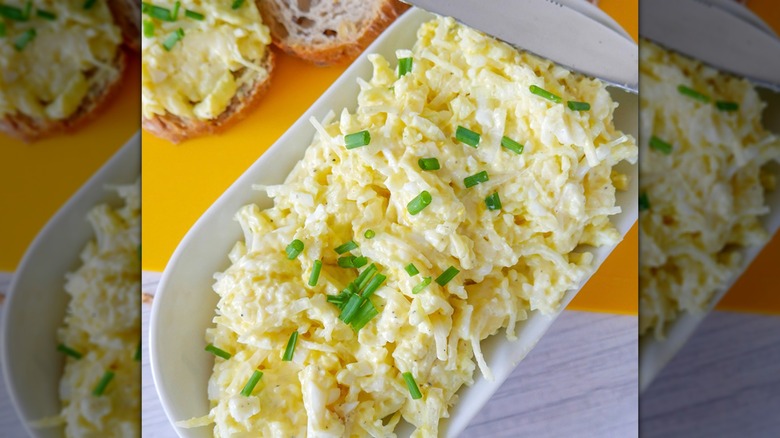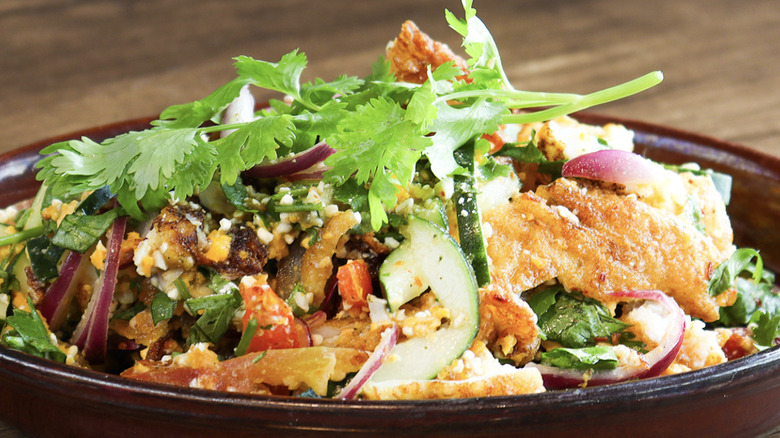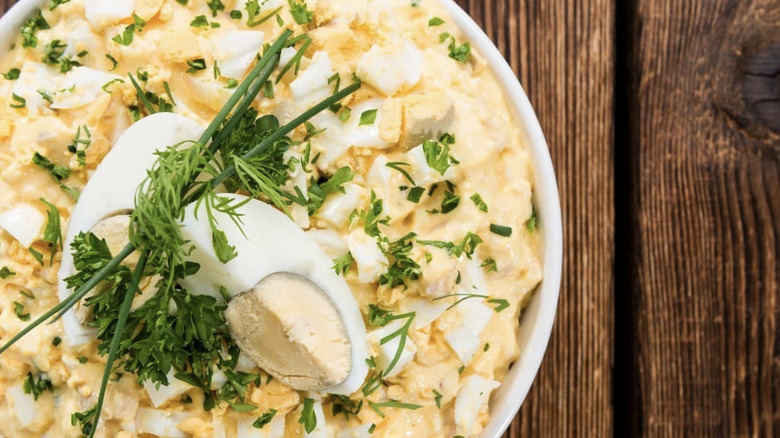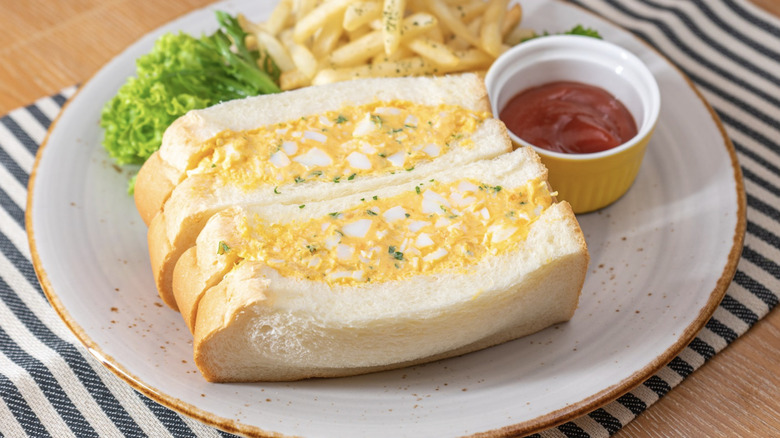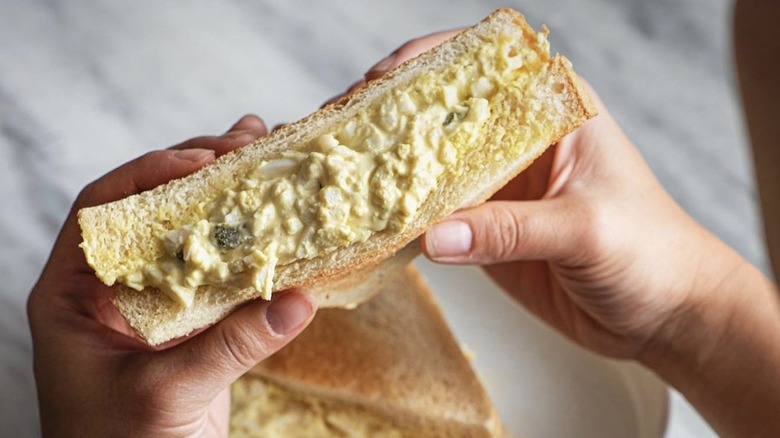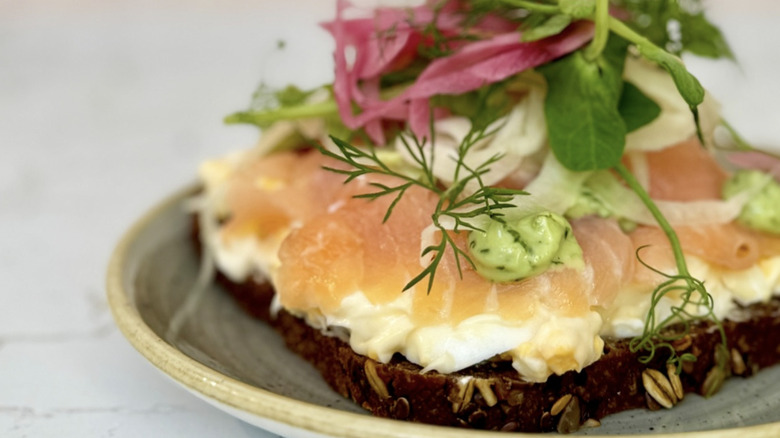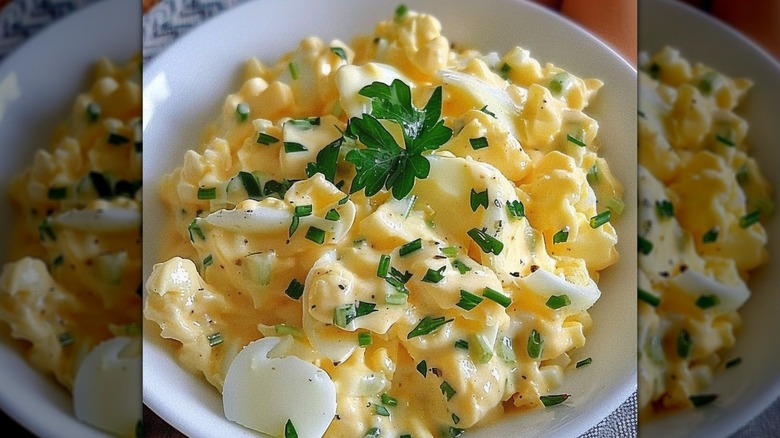The Best Egg Salad Variations From Around The World
When most of us think of an egg salad, we automatically conjure images of a creamy mix of finely chopped hard-boiled eggs, mayonnaise, and a few add-ins such as carrots, celery, and chives. However, not all egg salads are created equal. Chefs around the world have put their own spins on this iconic dish, infusing it with local ingredients and flavors. These culinary efforts showcase not just different food traditions, but the exceptional potential of this humble dish.
While eggs have been around since time immemorial and mayo is said to have been invented by a French chef in 1756, the combination of the two didn't become popular until the early 20th century. In fact, one of the earliest recipes for the version of the dish we are most familiar with, but using butter instead of mayo, was published in The Journal News in Hamilton, Ohio, in 1899.
Whatever the recipe, it's hard to say no to a perfectly-crafted egg salad. Whether served on its own, as a side, or piled between slices of white bread, the dish features a winning combination of flavors and textures. Got an appetite? Check out our list of the best egg salads from around the world.
American egg salad
While there are many different takes on American egg salad, at its most basic, the dish is made with a few very simple ingredients and can be put together in minutes. If you don't have a lot of time on your hands, try making the traditional version of egg salad by combining hard-boiled eggs, mayonnaise, mustard, and a little salt and pepper to taste. To make the dressing, add 1 teaspoon of mustard for each ⅓ cup of mayo and six eggs.
While the classic egg salad recipe is very simple, countless variations exist, allowing for customization with spices, herbs, or alternative dressings to suit different tastes and occasions. For instance, for a classic egg salad with a twist, combine hard-boiled eggs, mayo, and mustard with curry powder and chopped red onions. These ingredients can add flavor and texture to the dish, enhancing it with a little spice and crunch. As a final touch and a burst of color, sprinkle the egg salad with chopped chives.
Chinese egg salad
When it comes to Chinese-style egg salad, the main stars of the show are century eggs. Also called hundred-year-old eggs and millennium eggs, century eggs are normally dark in color, creamy in texture, and rich in umami flavor. This is thanks to their preparation process, which involves a good soaking in a mixture of salt, clay, wood ash, and quicklime. This curing process can take weeks and even months. While the exact history of century eggs isn't clear, it's believed that eggs were first cured in China some 600 years ago for preservation purposes.
Also sometimes called Yam Khai Yiaw Ma, Chinese century egg salad combines century eggs with a bold and flavorful dressing. If you want to make this culinary gem at home, your best bet is to search for century eggs in the refrigerator aisle of your local Chinese grocery store. Similar to the eggs, the salad dressing in the dish packs a flavorful punch. This is reflected in its ingredients, which typically include garlic, chili, scallions, cilantro, rice vinegar, and soy sauce.
Greek egg salad
Most of us are familiar with Greek salad. Often served as a light side dish or appetizer, it normally features ripe tomatoes, crisp cucumbers, Kalamata olives, and chunks of creamy feta cheese. Greek salad is traditionally drizzled with a simple mix of olive oil, lemon, red vinegar, and spices.
In many aspects, Greek egg salad isn't all that different from the Greek salad we all know and love. Besides halved or chopped up hard-boiled eggs, the dish also features tomatoes, cucumbers, olives, and feta. However, unlike many other egg salads, this version of the dish doesn't normally come with a mayonnaise dressing. Instead, Greek salad is dressed in a mixture of plain Greek yogurt, red wine vinegar, garlic powder, and spices such as oregano, thyme, and basil. If this dressing doesn't sound to your liking, you can replace the Greek yogurt with tzatziki, hummus, or even pesto. Other optional ingredients that are also sometimes thrown into the mix include arugula, carrots, and avocado.
Turkish egg salad
Turkish egg salad — also called yumurta piyazi — is a lot greener than many of its eggy counterparts from around the globe thanks to the abundant parsley. It's also very simple to prepare. Aside from the hard-boiled eggs and the freshly chopped parsley, the dish calls for sliced scallions, olive oil, red pepper flakes, and salt. Instead of being finely chopped, the eggs in this recipe are quartered lengthwise and gently arranged to keep their shape.
There's really nothing negative we can say about the Turkish take on egg salad. For starters, it's lighter and doesn't have the high calorie and high saturated fat content of mayonnaise, which is so often used in egg salads. Alongside fresh ingredients, the salad incorporates olive oil as dressing, which is rich in healthy fats and antioxidants and is known for its anti-inflammatory benefits. In addition, if you're making this version of egg salad at home, you can substitute regular olive oil for extra virgin olive oil for added health benefits.
Hungarian egg salad
According to one story, Hungarian egg salad, or Tojáskrém, was first concocted by a chef who used to cook for royalty. Which royalty this was exactly isn't certain, however, as the story goes, the chef ended up whipping up culinary delicacies — presumably including the said egg salad — at the National Casino in Budapest.
What makes Hungarian-style egg salad stand out from the pack is its use of sour cream and butter instead of mayo. While recipes for the dish vary, some popular ingredients that go into this salad include white vinegar, red paprika, capers, fresh chives, and chopped red onions or shallots. One recipe even calls for minced anchovy filets.
Another notable feature about Hungarian egg salad is the egg preparation. Instead of being mashed up together, the hard-boiled egg whites and yolks are separated. While the egg yolks are whisked together with the sour cream, butter, and pepper until smooth, the whites are coarsely chopped and added to the salad later to add some texture to the dish.
Russian egg salad
Also known as Olivier egg salad, Russian egg salad was invented by a French chef, Lucien Olivier, who worked at the Hermitage in Moscow in the 1860s. While the recipe for the dish was top secret at the time, we now know that it consisted of eggs, veal tongue, hazel grouse, caviar, capers, pickles, lettuce, and a mayo-based salad dressing. For those not in the know, hazel grouse is a small game bird native to northern Eurasia. When the recipe for Olivier egg salad was first published in 1897 in "A Guide to the Study of the Foundations of Culinary Arts," it no longer included caviar and veal tongue, but instead called for potatoes.
While recipes for Olivier egg salad vary widely, most versions contain eggs, green peas, potatoes, and mayonnaise. Aside from these key ingredients, however, there are very few rules. Common additions to the dish include carrots, apples, bell peppers, beets, asparagus, olives, and pickles. A variety of chopped up meats is also often added to the salad, including chicken, ham, or sausage.
Polish egg salad
What makes the Polish egg salad, or pasta jajeczna, unique is the addition of cream cheese, an ingredient that gives the dish a rich and smooth texture. The cream cheese is often mixed with a little butter or mayonnaise, depending on the recipe. That said, many of the other building blocks of the dish are similar to those found in a classic American egg salad. Both versions are made with chopped boiled-eggs and other optional ingredients including chopped chives, onion, parsley, and salt and pepper.
Eggs are quite popular in Poland, as attested to by their inclusion in numerous recipes. For instance, another salad that includes hard-boiled eggs is sałatka jarzynowa, or vegetable salad. Featuring a mayonnaise base, this version of egg salad is ideal for those who prefer variety in their salads since it's composed of potatoes, carrots, celery, peas, and green onion. Another popular Polish egg-based dish is deviled eggs, or jajka faszerowane. There are plenty of variations on this popular menu item, including herb deviled eggs, pickle deviled eggs, horseradish deviled eggs, and red beet deviled eggs.
Thai egg salad
Unlike most egg salads, which feature boiled eggs, Thailand's yam khai dao calls for crispy, fried eggs. To obtain the right consistency, the eggs are shallow fried in hot oil. This ensures that the yolks stay nice and runny while the whites end up with thin and crispy edges. Once broken, the yolks mix with the salad's dressing, softening its bold flavor profile. Spicy and fresh, Thai egg salad is typically served as an accompaniment to other dishes such as soups or curries.
Aside from fried eggs, Thai egg salad is also unique due to its zesty dressing. In other words, you won't find any mayonnaise or cream based ingredients in this dish. Instead, the egg salad presents the perfect blend of spicy, sweet, salty, and acidic flavors. While the exact ingredients that make up the dish can vary — Chinese celery and tomatoes are common — the dressing it typically made with Thai chilies, fish sauce, lime juice, palm sugar, cilantro, and garlic. With such a flavor-packed lineup, this dish presents a refreshing alternative to more traditional egg salad recipes that may hit the right notes with more adventurous diners.
Spanish egg salad
Spanish egg salad, or ensalada de huevo, is surprisingly simple to make. In contrast to other classic egg salads, this dish calls for a handful of basic ingredients that you are likely to already have in your kitchen. Aside from hard-boiled eggs and mayonnaise, the key elements in the creamy dish include extra virgin olive oil, garlic, and fresh parsley. This trio, known as aceite de ajo y perejil in Spanish, is a popular dressing in Spain, commonly drizzled over pasta, seafood, and meat dishes.
Aside from aceite de ajo y perejil, recipes for Spanish egg salad can include a variety of flavor nuances. Some versions of the dish incorporate zesty ingredients like lemon juice, Dijon mustard, and pimentón (Spanish smoked paprika). Others call for sweet Spanish onion and green olives. Some takes on the dish also include jamón Serrano, or cured ham sourced from the hind leg of a pig, which pairs exceptionally well with the creaminess of the eggs and mayonnaise.
Indian egg salad
When we think of Indian food, we normally picture biryani, butter chicken, samosas, and tandoori chicken. Conversely, we don't normally associate the Indian culinary tradition with egg salads. Little did we know that Indian gastronomy shines even in this area with egg chaat. This vibrant dish combines hard-boiled eggs with the zesty flavors for which Indian food is so famous around the globe. Interestingly, the word "chaat" refers to a range of flavorful Indian street food rather than a specific dish or spice. So, why the name? Indian egg salad often incorporates chaat masala powder, a spice commonly used in street food.
Indian egg salad combines hard-boiled egg halves with a topping of fresh veggies and herbs. Some of the ingredients commonly used in the dish include tomatoes, cilantro, lime juice, onions, as well as green chilies and red chili powder for an extra kick. Indian egg salad is typically garnished with sev, a type of crispy Indian noodle made from chickpea flour and seasoning like turmeric and cayenne. The noodles are often broken into small pieces and sprinkled over a dish.
Japanese egg salad
Tamago sando, or egg sandwiches, are a ubiquitous treat in Japan. This on-the-go snack is available at most convenience stores and even some vending machines throughout the country. Aside from the delicious eggy filling, the treat is typically made with shokupan, a milky Japanese bread that's fluffy and mildly sweet. The bread usually comes without crust, in keeping with the soft texture of the sandwich.
Just like the bread it's nestled in, the eggy filling is also relatively light and uncomplicated, consisting of very basic ingredients. More specifically, the recipe for Japanese egg salad includes hard-boiled eggs, mayonnaise, salt, pepper, sugar, and milk. However, as with many dishes, the beauty of Japanese egg salad lies in the details.
The filling of tamago sando is made using Kewpie mayo, a smooth, umami-flavored Japanese mayonnaise made with egg yolks rather than entire eggs. Another detail lies in the way the sandwich is prepared. Instead of being mashed together, the egg yolks and whites are separated. While the egg yolks are whisked with the other ingredients, the egg whites are chopped more coarsely, adding a unique texture to the filling.
French egg salad
French egg salad is as simple as it is elegant. Translating to œuf mayonnaise in French, the dish consists of hard-boiled egg halves topped with a mayo-based dressing. The halves can be served face down or face up for a slightly different presentation. Once the darling of Parisian bistros, at its most basic, the dish consists solely of hard-boiled eggs and mayonnaise. Other recipes, however, elevate the appetizer's flavor with additional ingredients. For instance, some variations include Dijon mustard, lemon juice, vinegar, black pepper, and salt. French egg salad is also sometimes served on a single lettuce leaf and garnished with colorful ingredients like chopped chives or green onions, celery leaves, and halved cherry tomatoes.
For the French, œuf mayonnaise means serious culinary business. There's even an association dedicated to the unassuming dish. Founded in 1990, L'Association pour la Sauvegarde de l'Œuf Mayonnaise — or the Association to Protect Egg Mayonnaise — organizes annual competitions that see chefs compete to make the best œuf mayonnaise.
Scandinavian egg salad
In Norway, Sweden, and Denmark, egg salad is often served on smørrebrød, or open-faced sandwiches. More specifically, the creamy salad makes the perfect pairing for buttered Scandinavian dark rye bread. Smørrebrød are typically served with a variety of other ingredients such as arugula leaves, radish slices, and smoked salmon.
The Scandinavian take on egg salad features a creamy base made with a blend of mayo, Dijon mustard, and sour cream. Some recipes replace the sour cream with crème fraîche or yogurt. The egg yolks are usually blended with the dressing, while the chopped whites are typically added later to give the dish a slightly chunky texture. Unlike some other egg salads, Scandinavian egg salad also incorporates herby elements. While these vary in different recipes, common additions include chopped chives, cilantro, tarragon, basil, and parsley. To incorporate a tangy element, some chefs also finish the dish with capers and a dash of lime juice.
German egg salad
A symphony of contrasts, German egg salad, or eiersalat, pairs the creaminess of eggs and mayo with the zesty flavor of dill pickles and the crispy texture of sweet apples. While not altogether different from other mayo-based egg salads, this combination of ingredients is surprisingly refreshing. Since German egg salad should have a salad-like rather than paste-like consistency, the ingredients are normally chopped coarsely rather than mashed.
Like most other egg salads, German egg salad is ultra versatile, which means that you can customize it to suit your personal palate. Some ingredients you may consider adding to your German egg salad include fresh dill, parsley, and green onion — all of which provide a great contrast to the zesty nature of this dish. Other optional additions that often find their way into the dish include lemon juice and mustard, as well as less likely suspects such as curry powder, paprika, and sour cream.
